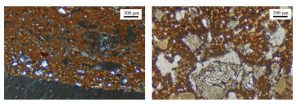An archaeometric study on pottery from different archaeological sites (Capalbiaccio, Colle Massari, San Martino in Piano, Rocchette Pannocchieschi, Donoratico, Castellina, Rocca degli Alberti and Casa Andreoni) located in south-western Tuscany (in a territory within the Colline Metallifere and the Tyrrhenian Sea) is carried out in the framework of the nEU-Med project promoted by the Department of History and Cultural Heritage of the University of Siena (UNISI).
The study is focused on the characterization of some ceramic samples associated with small transport container, probably dedicated to ground transportation and trade of goods within the territory.
The archaeometric investigation consisted of a petrographic, mineralogical and textural investigation of the ceramic bodies carried out via optical microscopy on thin sections and chemical analysis via Inductively Coupled Plasma Mass and Optical spectrometries (ICP-MS and ICP-OES, respectively) on very low amounts (<3 mg) of powdered samples.
A preliminary petrographic investigation suggested a good standardization of both materials and manufacturing techniques for most of the samples, except for some sherds from Rocchette Pannocchieschi, Castellina and Rocca degli Alberti. The use of iron-rich and highly-purified clays was stressed for the majority of the samples, while the presence of large sub-angular quartz and feldspar inclusions (> 200 mm to 1mm) for the other samples suggested the intentional addition of a temper by the potter to improve the plasticity of the clays.
The chemical investigation of the samples is also in progress for a quantitative analysis of major, minor and trace elements (MgO, SiO2, K2O, CaO, Al2O3, TiO2, Fe2O3, Na2O, P2O5, Sr, Zr, Ba, Pb, Cr, Zn, Cu, Mn, Ni, V, Rb e Y), together with rare earths (La, Ce, Pr, Nd, Sm, Eu, Gd, Tb, Dy, Ho, Er, Tm, Yb e Lu), with the aim to provide clues about the local provenance of raw materials (clays and tempers).



